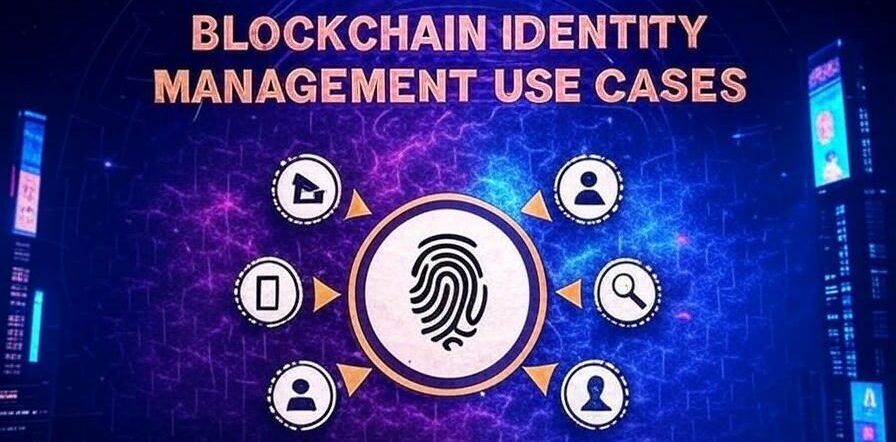In 2025, the concept of blockchain digital identity is rapidly gaining traction as a secure, privacy-first alternative to traditional systems. It has turned out to be one of the strong tool in a world where living is progressively putting personal data in jeopardy, promising to change the face of digital identity and improve personal privacy. This is because blockchain is decentralized and secure, offering an alternative to traditional digital identity systems whereby users are in a better position to have more power over their information and who can access it. This article discusses how blockchain technology reshapes digital identity and privacy, what benefits are associated with the adoption, and what challenges are standing in its way.

What is Blockchain, and Why is It Important for Digital Identity?
Blockchain is essentially a distributed, digital database technology that records transactions over a network of computers. As compared to traditional databases managed by a central authority, blockchain leverages a distributed network to be significantly more secure and less vulnerable to data manipulation.
The following are some of the most important benefits blockchain can bring to digital identity:
1. Decentralization: The user is not dependent on a central authority or any third-party organization in the management or storage of one’s personal data.
2. Enhanced Security: Blockchain uses encryption, making it much harder for hackers to access and manipulate data.
3. Transparency and Control: With blockchain, users can choose who gets access to their information and under what terms, thus providing greater privacy and control.
With these attributes, blockchain may act as an enabler for digital identity solutions that give ownership of the data to the people while reducing the cases of data breach and identity theft.
How Blockchain Improves Digital Identity
Traditional digital identity systems store personal information in centralized databases that can be breached. Blockchain enables the storage of digital identity information in a decentralized manner, hence difficult for malicious actors to breach. How is blockchain going to change digital identity? Let’s find out.
1. Self-Sovereign Identity (SSI)
Self-Sovereign Identity (SSI) allows individuals to own, control, and manage their digital identities without relying on centralized institutions. Blockchain enables SSI by allowing users to store and share identity data securely and selectively.
How It Works: On the blockchain, a digital wallet would be created containing users’ identity information. One wouldn’t have to share their whole identity details with service providers. They may say, “I am above eighteen” or “I am a citizen” by verifying attributes that will not give away some crucial information.
Example Use Case: For an age-restricted service, one can verify one’s age from a blockchain-based identity wallet upon creating an account, but without necessarily sharing the full date of birth.
Impact: SSI enhances privacy by letting users share only the minimum required information, reducing the amount of personal data shared with multiple parties.
2. Decentralized Identifiers (DIDs)
Decentralized Identifiers, or DIDs for short, are a type of singular, verifiable digital identifier that one self-creates and self-manages on blockchain networks. DIDs enable users to use multiple identities related to their different online services, yet remain private and secure.
How It Works: Users create different DIDs for work, social media, or banking. Each DID exists independently of others, and verification for one does not need to compromise other identities.
Example Use Case: A professional can use one DID in business interactions and another one in personal activities, thus maintaining work-life separation but at the same time verifiable.
Impact: DIDs empower users with their own identity online, thus providing a bigger degree of privacy and the possibility of verified identity across several platforms.
3. Improved KYC (Know Your Customer) Processes
Know Your Customer (KYC), in general, is a much-needed check for customer identity verification in banking, finance, and other related fields. Traditional KYC requires long processing and high charges for the processing, forcing customers sometimes to submit the same information multiple times to different organizations. It could potentially be simplified into a single verified digital identity that can be used across numerous sites using blockchain technology.
How It Works: In the blockchain, KYC data for a user is stored and shared with an organization. Instead of going through each entity’s separate KYC check, a user can allow any organization to access his verified identity.
Example Use Case: A customer can complete KYC with any bank and then use the same verified identity to create accounts with other financial institutions. This will save time and increase security.
Impact: Blockchain-based KYC processes minimize corporate redundancies and expenses while improving client data security and privacy.
Privacy Benefits of Blockchain in Digital Identity
Some of the key blockchain-derived privacy benefits for digital identity management may be pointed out as follows, addressing issues at which traditional systems of identity have miserably failed:
1. Data Minimization
Blockchain facilitates the user’s providing of only the minimum information to meet the requirement, thus keeping privacy intact. For example, when checking the age or verifying the status of citizenship, blockchain-based systems ensure verification of particular details rather than disclosing full identity.
Example: Instead of showing a full ID card to verify age, it will be enough for a user to prove that they are older than the specific age without exposing extra information about himself or herself.
Impact: The minimization ensures that cases of disclosure of too much information by users are reduced, which can lead to identity theft and breach of privacy.
2. Greater Data Security and Resilience
Because blockchain is distributed, hackers will have a far more difficult time accessing personal information. There is no one repository of information that an attacker can get hold of to, and if one node in the network fails, the remaining nodes are unaffected.
Example: In the event that a node in the blockchain network is attacked by a hacker, changing data would imply compromising the majority of the network, which is extremely laborious and resource-intensive.
Impact: The security features of blockchain make it very resistant to data breaches, providing customers more trust in the preservation of their digital identities.
3. Consent-Based Data Sharing
Blockchain technology allows customers complete control over who can access their data and under what conditions. Users can request authorization for specific reasons and cancel it at any time, which is far more flexible than traditional identification systems.
Example: A user can grant access to his academic transcripts for job applications but then withdraw that access once the application process is completed.
Impact: Consent-based data sharing gives consumers greater control over their information, minimizes the chance of misuse, and offers a higher level of privacy.
Challenges Facing Blockchain-Based Digital Identity Solutions
While blockchain does bring a number of very promising digital identity solutions, there are indeed various challenges to pursue:
1. Scalability: The problems with blockchain networks mostly lie in scalability issues, where blockchains cannot support high volumes of transactions in a fast way. Because digital identity will need huge volumes and be fast, blockchains need to be more scalable in the future.
2. Interoperability: Different blockchain platforms may not be able to support each other; therefore, it may be challenging for users to manage their identities across diverse systems. A standardization effort is going to be very important in creating smooth interaction for the users.
3. Regulatory Uncertainty: Blockchain technology is relatively new; thus, governments are largely in a dilemma over how to put a regulatory framework around it. The lack of clear regulations may be one more obstacle in the mainstreaming of blockchain-based digital identity solutions.
4. User Education: Blockchain-based digital identity requires a basic change in paradigm regarding how users think about their personal information. Users need to understand how to manage and protect their blockchain identities for general acceptance.

Examples of Blockchain-Based Digital Identity Initiatives
Several organizations and governments are already exploring blockchain for digital identity solutions, thus setting the stage for the adoption of the same in times to come:
ID2020 Alliance: A worldwide initiative aimed at providing secure, blockchain-based digital identities to people from all over the world, especially to those who don’t have formal identification. Working on designing inclusive identity solutions with governments, non-profits, and private companies, the alliance works in design and creation.
Sovrin Network: The Sovrin is a nonprofit organization that deals in decentralized identity in a digitized format. Working on the public-permissioned blockchain, Sovrin allows for keeping privacy and personal data control with their owners.
Microsoft’s ION: The project on the Bitcoin blockchain by Microsoft, ION, lets users create decentralized identifiers that could be used across different platforms. This solution focuses on user control and privacy, thereby relating correspondingly to self-sovereign identity.
Future Outlook: Blockchain’s Role in Digital Identity and Privacy
This is where blockchain can change the face of digital identity and privacy when the technology matures. How could this happen?
Adoption in Financial Services: Banking and financial institutions would jump at the opportunity to adopt blockchain-based identity solutions to serve multiple use cases: smoothing onboard processes, enhancing security, and decreasing compliance costs.
Government-Issued Digital IDs: A number of governments, like those in Estonia and the United Arab Emirates, are playing with the idea of blockchain-based digital IDs, while many more remain to join. This will reduce some headaches in citizen services, increase access, and thus enhance security.
Integration with IoT and Smart Cities: This is where blockchain-based identities could become critical in the management of smart city infrastructure, where identities need to be verified in a secure fashion to interact with IoT devices and urban services.
Challenges Ahead: The way such blockchain-based digital identity systems will meet regulatory challenges, find interoperability, and win people’s confidence remains a challenge. As this technology evolves and user awareness grows, blockchain could alter the way digital identity and privacy are managed forever.
Conclusion
Blockchain technology is proven to be beyond cryptocurrency and bringing a change to the very concept of digital identity towards a more secure, centered-privacy-based approach to managing personal information. By doing so, it positions blockchain-based systems of digital identity as a solid solution to data security, privacy, and transparency challenges because users can manage their information and be less dependent on centralized institutions.
Going into 2025, the role of blockchain in digital identity will continue to evolve: a safer, more efficient method for both individuals and organizations to verify identity and share data. Admittedly, there are still a variety of challenges to be resolved; however, the promise of such a decentralized model of identity is fairly straightforward: greater control for the individual, reduced security risks, and a more transparent digital ecosystem. Blockchain technology may hold the key to a future where privacy is protected and digital identity is secure.
